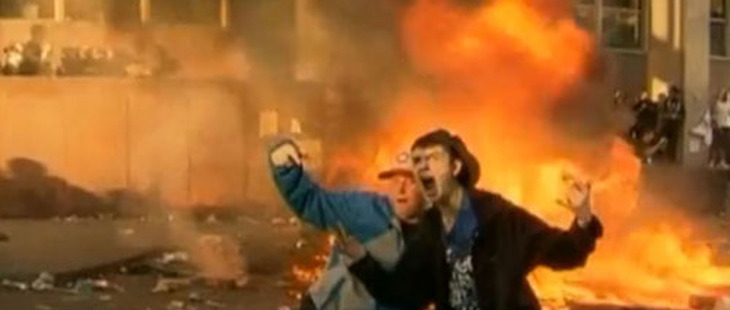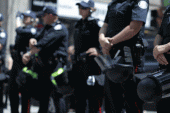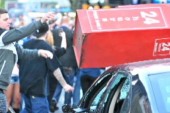
A burning car makes great TV. This much we can all agree on. It doesn’t, however, turn Vancouver into Toronto.
Unfortunately, the visual parallels between the Vancouver riots and the G20 in Toronto — the broken glass, the smoking street, the smoldering police cars — are leading observers to make all kinds of spurious connections between the two events. The insinuation is that they represent two sides of the same coin, or two book-ends of trans-continental mob violence.
“Looking at Vancouver, thinking about the G20. I wonder if it’s time we just accepted that this is what a lot of Canadians are like,” wrote a friend on Facebook.
“Torontonians bashing Vancouver rioters? That’s rich. We had G20 last yr & would likely have riots if our team lost in Stanley Cup finals,” read one of many similarly-themed tweets coursing through the Internet.
Nothing could be further from the truth.
The comparisons spring from visual comparisons, as well as persistent misunderstandings about what happened at the G20. The spate of vandalism that happened at the G20 was perpetrated by a small group over a short period of time. The rest was a rowdy, but relatively damage-free political protest that was the subject of an astounding police crackdown. The two events were different as apples and oranges.
This isn’t about Toronto vs. Vancouver. There could well be a drunken hockey mob in waiting here, too. By the same token, the G20 vandals, the G20 protestors, and the G20 police all came to Toronto from across the country. No, this is about two events that look similar on TV, but in reality have far less to do with each other than many seem to think.
Here’s why:
“It was just a handful of hooligans” is a myth in Vancouver, but a reality at the G20. It’s always nice to blame an “outside” influence for this kind of thing. Today, Vancouver is in a tussle about whether or not there was “anarchist” involvement in the riots there.
Whether or not there were radicals in the mix in Vancouver — and surely there were — the critical distinction is that the crowd joined in, and hooliganism became a mob action.
At the G20, on the other hand, the violence was premeditated, targeted, and isolated. Moreover, the brief spate of property damage perpetrated by a few did not generate any interest in the thousands of protestors nearby.
Perhaps ironically, the bulk of the G20 protestors who were around at the time of the vandalism were far less interested in being drawn into a riot than hockey crowds were. For one thing, most were invested in the idea of peaceful protest. For another, they were sober.
There was almost no looting, and relatively little property damage at the G20. TV images made the G20 property damage look widespread. In reality, the only major outbreak of property damage was by a group of “black bloc” vandals who waited until the end of the protest parade, and went on a quick parade of their own, breaking off in the opposite direction for a bit of infantile smash-and-run that followed a linear route.
They started near Queen and Spadina, moving east and dipping into the financial district, where a police car was torched (a disturbed, half-naked man, who I’d witnessed earlier in the day perched almost suicidally atop a war memorial, was charged), then headed north on Yonge to around College and west to Queen’s Park, where they changed clothes and dispersed. Along the way, they smashed windows of franchises that offended their sensibilities, and moved on. (The Toronto Star’s excellent account, written by reporters who followed the vandals, explains how they worked.)
I followed the vandals’ route myself, 15 minutes later. It was a mess, but there was no riot and no mob. Bystanders stood, a little dazed, some taking photos. There was no looting to be seen.
The police actions at the G20 had (sadly) little to do with the vandalism. The G20 vandalism happened independently of the police actions that defined the event. The vandalism happened in the late-afternoon; the police violence and mass arrests only got underway after the damage was done and the vandals were gone. In fact, the police let the vandals act and disperse without lifting a finger against them.
The protestors who remained scattered across the city into the evening were certainly angry, and sometimes rowdy, but largely didn’t engage in property damage or vandalism. They gathered, they chanted, they sat on city streets where police didn’t want them. And for that, they were beaten and hauled away.
The police started deploying ever-more aggressive tactics against people on the streets, including mass arrests, kettling, riot-line charges and beatings, in the service of secret laws and spurious “breach of peace” charges. To reiterate, these were not directed at vandals, who were long gone, or even at particularly unruly protestors. Journalists were detained. People out to get groceries were detained. People out walking their dogs got detained. People who took the wrong turn on their bike were detained.
Protest is legitimate. At the G20, it’s important to distinguish between “vandals” and “protestors.” The two are not synonymous: One is illegal and loathsome; the other is utterly necessary.
Not all of the protestors were “peaceful protestors.” There were plenty of protestors who were angry, rowdy, obnoxious, difficult, thoughtless, ill-informed, in-your-face and totally dislikeable. That doesn’t mean they ran around smashing things, or breaking the law. Whatever you make of their politics, their presence was entirely legitimate.
There was no single motive shared by the G20 protestors, just like there is no single incentive that drove the Vancouver mobs to do what they did. But let’s be clear: Protest is a legitimate thing to do on the streets of a city.
To compare a seething mob of drunken douchebags who took the chance to run amuck at the Robson St. Sears, beating those who stood against them while taking cellphone snaps of themselves going “woo hoo!”, with a group of vandals who did a run through Toronto and dispersed is inaccurate. However, to compare a seething mob of drunken douchebags with those who protested what happened at the G20 is simply wrong.















